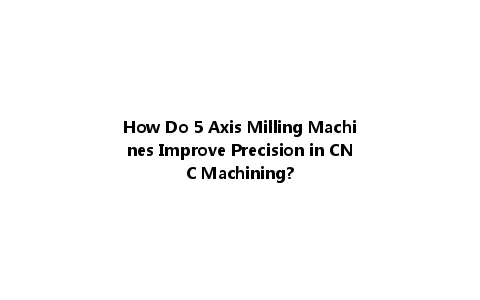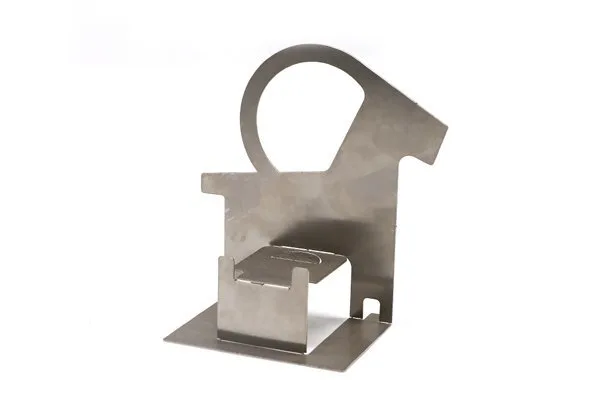When you think of modern manufacturing, what comes to mind? Perhaps it’s the roar of powerful machines, the impeccable precision of cutting tools, and the fine details that transform raw materials into innovative products. Among these machines, 5 axis milling machines stand out, boasting the ability to perform intricate cuts and complex geometries that were once the stuff of dreams. But how exactly does 5 axis milling technology revolutionize precision in CNC (Computer Numerical Control) machining? Buckle up, because we’re about to dive into an engaging exploration of this fascinating topic!
Understanding CNC Machining
To grasp the significance of 5 axis milling technology, let’s start with the basics: What is CNC machining? CNC machining is a manufacturing process that utilizes computers to control machine tools—including lathes, mills, routers, and grinders. In shorter terms? It’s automation at its finest, taking the workload off human hands while ensuring top-notch precision. Imagine turning a block of aluminum into a beautifully detailed part without breaking a sweat—that’s the magic of CNC!
The Evolution of CNC Technology
CNC technology has come a long way since its inception. Initially, CNC machines operated on a simple 2D plane, just like painting a flat canvas. As complexity in design and function grew in engineering, the need for advanced machining techniques emerged. Enter the 3 axis machine, which allowed movement along the X, Y, and Z axes—think of it as painting in three dimensions. But as demands for precision and versatility increased, so did the development of 4 and finally, 5 axis machining.
What Is 5 Axis Milling?
So, now you’re probably asking, What exactly is 5 axis milling? Picture a robot arm that can glide around a multi-sided sculpture, reaching and cutting from various angles to achieve that perfect finish—this is what 5 axis milling does in a nutshell. These machines can rotate on five different axes simultaneously, making it possible to create intricate components with complex geometries.
The Breakdown of the Axes
Let’s clarify those axes for a moment. A typical 5 axis milling machine can move in the following directions:
What makes this combination special? It allows the machine to access the part from nearly any angle, reducing the need for multiple setups and enhancing production efficiency. It’s like having an artist who can paint and sculpt simultaneously—talk about multi-talented!
Precision: The Heart of 5 Axis Milling
Now that we know what 5 axis milling brings to the table, let’s dive into why precision matters. In industries ranging from aerospace to medical devices, precision isn’t just a nice-to-have; it’s a life-or-death requirement. Tight tolerances and detailed specifications define the quality and functionality of a part. Mistakes aren’t just errors; they can lead to catastrophic failures.
How Does 5 Axis Improve Precision?
With its capability to reach complex and intricate angles, 5 axis milling minimizes the chances of human error in alignment and positioning. Imagine crafting a delicate jewelry piece—getting every angle just right means the difference between a stunning masterpiece and an unfortunate mishap. This technology enhances:
Benefits of 5 Axis Milling Over Traditional Methods
You might be wondering, Why not just stick with 3 or 4 axis machines? While both have their advantages, working with a 5 axis machine introduces a myriad of benefits, including:
Think of it this way: if traditional machining is like using a basic toolkit, 5 axis milling is akin to having a deluxe toolkit complete with specialized attachments—designed to get the job done faster and more efficiently.
Applications of 5 Axis Milling Technology

From aerospace components to medical devices, 5 axis milling technology is a hero in numerous fields. Let’s explore some of the industries that truly benefit from this advanced machining process.
Aerospace Industry
In aerospace, precision is non-negotiable. Components like turbine blades and housings often require extremely tight tolerances to keep aircraft operational and safe. With 5 axis milling, manufacturers can produce complex shapes needed for high-performance parts while adhering to strict safety regulations.
Automotive Industry
In the automotive sector, the demand for lighter and more fuel-efficient vehicles means incorporating cutting-edge materials and components. Engineers can leverage 5 axis milling machines to create intricate suspension components or engine parts that promote efficiency without compromising strength.
Medical Devices
The medical industry often relies on bespoke equipment and devices tailored to individual patients. 5 axis technology allows manufacturers to create customized implants, tools, and devices with precision, delivering solutions that significantly enhance patient care.
Mold Making
Mold making is yet another realm that benefits immensely from 5 axis milling. Complex molds for the production of consumer goods and packaging require intricate designs that can be flawlessly executed with this technology.
Challenges of 5 Axis Milling
Of course, no technology is free from complications. Along with the numerous benefits come certain challenges.
Learning Curve
Operating a 5 axis machine isn’t as simple as pressing a button and watching magic happen. It requires skilled technicians who understand both the machine and the intricacies of CAD/CAM (Computer-Aided Design/Computer-Aided Manufacturing) software. Without proper training and expertise, the potential for error increases.
Machine Costs
Let’s face it—5 axis machines come with a price tag that can make your jaw drop. The initial investment might be steep, which can discourage smaller manufacturers from jumping on board. However, many find that the benefits outweigh these early costs, leading to improved profitability in the long run.
Maintenance
Like any advanced machinery, 5 axis machines require regular maintenance to operate smoothly. Downtime due to repairs can impact production schedules, so a commitment toProper upkeep is essential.
The Future of 5 Axis Milling
What does the future hold for 5 axis milling? The advancements in technology are ever-evolving, and there are a few exciting trends and innovations on the horizon:
Automation and AI Integration
As with many industries, the integration of automation and artificial intelligence (AI) into CNC machining processes promises to elevate precision further. Imagine machines that can analyze performance data in real time, adjusting cuts and speeds on the fly to optimize outcomes. Sounds like sci-fi, right? But it’s closer than you think!
Advanced Materials
With the advent of new materials like composites and advanced alloys, there’s a growing need for manufacturing processes that can handle these complexities. 5 axis machines are likely to adapt, allowing for cutting and shaping these unconventional materials with ease.
Increased Collaboration Across Industries
As the lines blur between industries, we can expect manufacturers to collaborate more closely. Sharing knowledge and techniques will lead to heightened innovation, and that’s fantastic news for everyone involved!
Conclusion: Why Embrace 5 Axis Milling Technology?
So, after exploring the depths of 5 axis milling technology, why should you consider incorporating it into your operations? The short answer: precision, efficiency, and innovation. This transformational technology empowers manufacturers to reach incredible heights, enhancing their ability to produce intricate parts with unmatched precision.
As the manufacturing industry continues to evolve, keeping pace with technological advancements is crucial for long-term success. Whether you’re an engineer, a business owner, or a curious enthusiast, embracing the potential of 5 axis milling can be your ticket to unlocking a world of possibilities.
Let’s take a moment to reflect: what innovations in manufacturing excite you the most? How do you envision the future of precision in the industries you care about? The journey of learning and exploration doesn’t end here—let’s keep the conversation going, share insights, and inspire one another!





